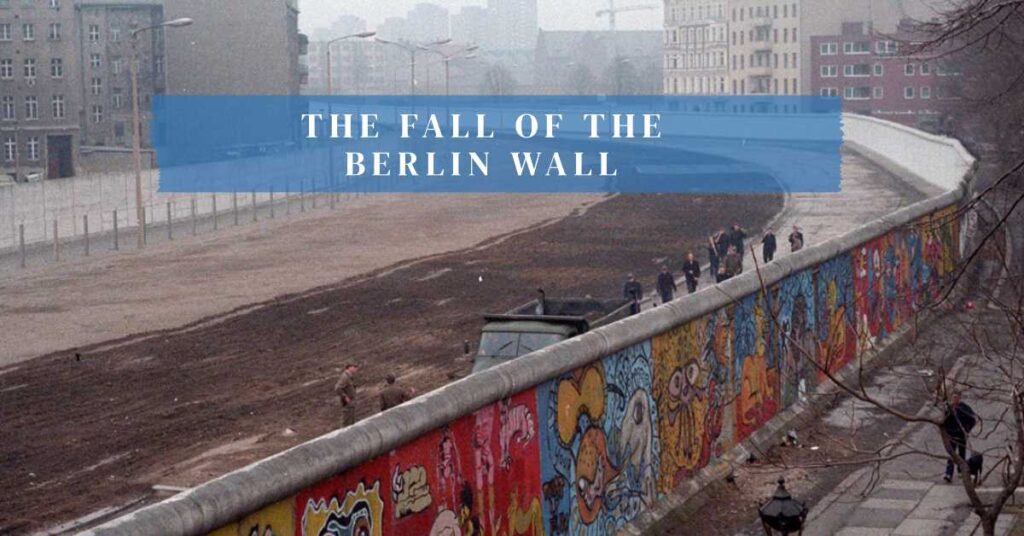The Berlin Wall, a symbol of division and oppression, stood tall for nearly three decades. Its construction in 1961 aimed to halt the flow of East Germans seeking a better life in the West. What started as a mere barbed wire fence soon transformed into a formidable concrete barrier, stretching 45.1 km.
However, on November 9, 1989, the wall’s grip on Berlin loosened, and it eventually crumbled under the weight of liberation.
Today, visitors can witness the remnants of this historic structure at various memorial sites and museums, such as Checkpoint Charlie and the East Side Gallery.
Construction and Length of the Berlin Wall
It was initially built as a low barbed wire fence, was later replaced with a concrete wall that stretched 45.1 km and included various security measures such as guard towers, bunkers, and minefields.
The construction of the wall had a profound impact on the lives of East Germans. It effectively divided families and friends, separating them from their loved ones on the other side. The Wall also prevented East Germans from freely traveling to the West, restricting their freedom and opportunities for a better life.
It created a sense of isolation and desperation among the East German population, leading to increased dissatisfaction with the communist regime. Despite the wall’s intended purpose of preventing defections, it ultimately fueled the desire for freedom and played a significant role in the eventual fall of the Wall in 1989.
Reasons for Building the Berlin Wall
To prevent mass emigration, the East German government erected the wall as a means of trapping its citizens and maintaining the communist regime. This decision had significant impacts on both the East German economy and the psychological well-being of the people in both East and West Berlin.
Impact on East German economy: The construction of the wall resulted in a sharp decline in the East German economy. The loss of skilled workers and intellectuals who fled to the West created a brain drain, leaving behind a labor shortage and stagnation in innovation and productivity.
Psychological effects on East and West Berliners: The Wall created a physical and psychological divide between families and friends. East Berliners lived under constant surveillance and faced restrictions on travel and communication. West Berliners witnessed the separation and were reminded of the oppression and lack of freedom experienced in the East.
Despite these hardships, the fall of the Berlin Wall in 1989 brought about reunification and a renewed sense of freedom for the German people.
Related Article: The Berlin TV Tower Ultimate Guide
Fall of the Berlin Wall
November 9, 1989, marked a significant turning point in German history with the fall of the Berlin Wall.
The reasons for the fall of the Wall were multi-faceted. The East German regime was facing increasing pressure from its citizens who were demanding political and economic reforms. Additionally, the Soviet Union, which had supported the construction of the Wall, was experiencing its own internal changes under Mikhail Gorbachev’s leadership.
The impact of the fall of the Wall was profound for both East and West Germany. For East Germany, it signaled the end of communist rule and the beginning of a reunification process with West Germany. For West Germany, it meant the reunification of the country and the opportunity for economic growth and political stability.
The fall of the Berlin Wall was a triumph for freedom and a symbol of the power of the people to overcome oppressive regimes.
Appearance of the Berlin Wall
Covered in vibrant graffiti, the West Berlin side of the Wall displayed the diverse views and expressions of the city’s residents. The graffiti on the Berlin Wall served as a powerful form of protest and a means of communication for those living in West Berlin. It allowed them to express their dissatisfaction with the communist regime and their desire for freedom.
The impact of the Berlin Wall on East Berliners’ daily lives, however, was quite different. They were cut off from the vibrant graffiti and the expressive culture of the West. Instead, they were faced with a high inner wall that separated them from the rest of the city. This physical barrier reinforced the isolation and control that the East German government exerted over its citizens.
The graffiti on the Berlin Wall served as a stark reminder of the stark divide between East and West Berlin, and the longing for freedom that persisted on both sides.
Checkpoint Charlie
Checkpoint Charlie, one of the most famous border crossings during the Cold War, served as a significant checkpoint for those traveling between East and West Germany. It holds immense historical significance and symbolizes the Cold War’s impact on the East-West border.
Located in Berlin, Checkpoint Charlie witnessed numerous escape attempts and became a symbol of the divisions caused by the Berlin Wall. Today, visitors can explore Checkpoint Charlie as part of a Berlin Wall tour and learn about the events that took place there.
The area surrounding the checkpoint is filled with remnants of the Berlin Wall, including sections covered in Berlin Wall art. Additionally, the Checkpoint Charlie Museum provides a comprehensive exhibition about the Cold War and the struggles faced by those living in East Germany. It stands as a reminder of the sacrifices made for freedom and the importance of preserving history at the Berlin Wall Memorial.
Topographie Des Terrors
The Topographie des Terrors, located in Berlin, provides visitors with a comprehensive exhibition about the history of the Berlin Wall and the events that took place during its existence. This museum offers a fascinating insight into the impact of the Berlin Wall on Cold War politics.
- The exhibition explores the reasons behind the construction of the Wall, including the desire to prevent mass emigration from East Germany and maintain the communist regime.
- It delves into the lengths that were taken to secure the border, such as guard towers, bunkers, and minefields.
The museum also highlights the fall of the Wall in 1989, starting with the tearing down of the border fence between Hungary and Austria. The appearance of the Wall, with its graffiti-covered West Berlin side, is showcased, reflecting the views and expressions of the West.
Lastly, the Topographie des Terrors is just one of the many places in Berlin where visitors can see remnants of the Wall and learn about its historical significance.
Memorial Sites and Museums
After exploring the significance of Topographie Des Terrors in understanding the history of the Berlin Wall, it is important to acknowledge the numerous memorial sites and museums dedicated to preserving the memory of this iconic structure.
These sites not only serve as a reminder of the physical barrier that divided Berlin for almost three decades but also highlight the impact it had on the lives of East German citizens.
By visiting these memorial sites and museums, individuals can gain a deeper understanding of the struggles faced by those living under the communist regime and the significance of the Berlin Wall in Cold War history.
These sites offer comprehensive exhibitions, artifacts, and personal testimonies, allowing visitors to reflect on the importance of freedom and the consequences of division.
The East Side Gallery
Covered in vibrant and thought-provoking artwork, the East Side Gallery stands as a testament to the resilience of the human spirit and the desire for unity.
The East Side Gallery is a section of the Berlin Wall that has been preserved and transformed into an open-air art gallery. It stretches for 1.3 kilometers along the Spree River in Berlin, Germany.
The gallery showcases over 100 murals created by artists from around the world, making it the longest-lasting and largest outdoor gallery in the world.
The artistic expressions in the East Side Gallery represent various themes such as freedom, hope, and unity, reflecting the historical significance of the Berlin Wall and the emotions surrounding its fall.
This iconic cultural landmark serves as a reminder of the power of art to inspire change and promote freedom.
Berlin Wall Memorial in Bernauer Strasse
The previous subtopic discussed the East Side Gallery, which is a preserved section of the Berlin Wall that has been turned into an open-air art gallery. Now, let’s shift our focus to the Berlin Wall Memorial in Bernauer Strasse.
This memorial offers a comprehensive exhibition about the history of the Wall and its impact on divided families.
The Berlin Wall had a profound impact on the lives of families who were separated by its presence. Many families were torn apart, with loved ones on opposite sides of the Wall. The Wall became a physical barrier that separated families, causing immense emotional pain and anguish. The stories of these divided families serve as a powerful reminder of the human cost of the Cold War.
Furthermore, the Berlin Wall holds immense significance as a symbol of the Cold War. It represented the division between East and West, between communism and democracy. Its construction and eventual fall marked a turning point in history, symbolizing the end of the Cold War and the reunification of Germany.
The Berlin Wall Memorial in Bernauer Strasse stands as a testament to this historical significance and serves as a reminder of the importance of freedom and unity.
Where to See the Berlin Wall Today
Visitors can explore various memorial sites and museums dedicated to the historical significance of the Berlin Wall. These sites offer a glimpse into the preservation of this iconic symbol of division and reunification.
- Checkpoint Charlie: One of the famous border crossings and a significant Berlin attraction, offering a firsthand experience of the Wall’s history.
- Topographie des Terrors: A place where you can see a part of the Wall and learn about its historical context.
- The East Side Gallery: A section of the Wall that has been preserved and turned into an open-air art gallery, showcasing powerful murals and messages of freedom.
- Berlin Wall Memorial in Bernauer Strasse: Offers a comprehensive exhibition about the Wall’s history, with informative displays and preserved segments of the Wall.
- Berlin Wall Foundation: Provides valuable insights into the historical significance of the Wall through exhibitions, educational programs, and research.
These sites not only serve as reminders of the past but also as symbols of hope and the importance of preserving freedom for future generations.
Frequently Asked Questions
How Did the Construction of the Berlin Wall Affect the Daily Lives of East Berliners?
The construction of the Berlin Wall had a profound impact on the daily lives of East Berliners. They faced daily struggles such as restricted movement, separation from loved ones, surveillance, and the constant psychological impact of living in a divided city.
Were There Any Escape Attempts or Notable Incidents at the Berlin Wall?
Escape attempts and notable incidents were common at the Berlin Wall. Desperate East Berliners tried to flee through tunnels, over the wall, or even in hot air balloons. These daring acts highlighted the oppression and desire for freedom.
What Role Did the International Community Play in the Fall of the Berlin Wall?
International cooperation and the influence of foreign governments played a significant role in the fall of the Berlin Wall. Their support for democracy and human rights helped fuel the desire for freedom among the people, ultimately leading to the wall’s demise.
How Did the Berlin Wall Impact the Relationship Between East and West Germany?
The Berlin Wall, built to prevent mass exodus from East Germany, had a significant impact on the relationship between East and West Germany. It caused economic disparities and cultural division between the two sides.
Are There Any Plans to Rebuild or Recreate Sections of the Berlin Wall for Historical Purposes?
No, there are no plans to rebuild or recreate sections of the Berlin Wall for historical purposes. The Wall’s historical significance is preserved through memorial sites, museums, and preserved sections like the East Side Gallery.

